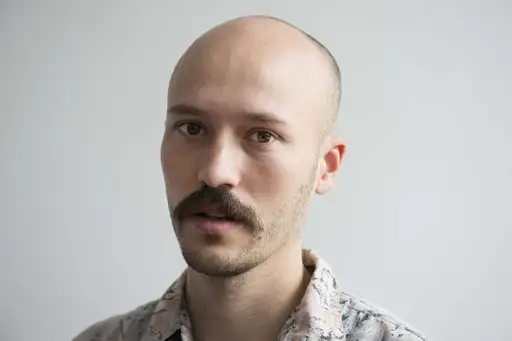output – interview
From the online publication "Fellows Published 2022-2023"
Charlie Clemoes participated in the fellowship programme in the academic year 2022-2023 with the research project "Insulation/Isolation: A Family Drama". The interview below is published in the online publication “Fellows Published” that was launched in December 2024. fellowspublished.rietveldacademie.nl/2023/charlieclemoes.html
What was the starting point of your research project?
My project started completely differently to how it ended up. I started with the aim of using the research time to make my theory teaching at Gerrit Rietveld Academie’s Architectural Design Department more grounded. I ended up writing a short story about a family Christmas dinner and insulation, and producing a highly subjective video about enclosure in the allotment just outside my back garden. This is because, firstly, I mistook the fellowship for a program where Rietveld and Sandberg Instituut teachers could improve an area of their teaching; and secondly, at around the same time that I was awarded the fellowship I received word that I had been selected for a year-long artistic residency at Jan van Eyck Academie, Maastricht, which twisted the scope of what I could do. On the one hand, I became free to focus entirely on my own practice, on the other, I had a lot more going on.
What has been your approach for the fellowship research project and how does it relate to the role of research in your practice?
Following on from the last answer, I saw the combination of the fellowship and my residency as a good excuse to try my hand at creative writing. I particularly wanted to see if I could use it as a tool in pursuit of one of the main drivers in my practice: making complex things—“totalities” or “hyperobjects” if you will—immediate and comprehensible.
When is architecture sustainable, or when are structures ecological? What stories do we tell ourselves about eco-architecture?
Architecture is sustainable when it sustains all life, which means that almost every claim of sustainability by architecture firms is false. Architecture is a fossil fuel industry. Architects are fossil fuel workers. This is because, to quote a headline figure, building is responsible for 40% of global carbon emissions. Even carbon-neutral buildings are wrapped in plastic. The sand used to produce concrete and reclaim land destroys whole islands in places like Cambodia. But this is just speaking of environmental sustainability; the construction industry is also inherently unsustainable in social terms. It thrives off of displacement and depends upon a global workforce that is frequently brutally exploited—especially if we look at the whole process, from mining to manufacturing and all the way to building. But none of this really matters because the word “sustainable” is so utterly vague so as to be essentially meaningless. In his book Keywords: The New Language of Capitalism (2018), author John Patrick Leary explains that any and all actors can lay claim to sustainable practices due to the temporal lag of counterevidence: “the final proof that our current practices are actually unsustainable will not come until after we are dead.”
My project started completely differently to how it ended up. I started with the aim of using the research time to make my theory teaching at Gerrit Rietveld Academie’s Architectural Design Department more grounded. I ended up writing a short story about a family Christmas dinner and insulation, and producing a highly subjective video about enclosure in the allotment just outside my back garden. This is because, firstly, I mistook the fellowship for a program where Rietveld and Sandberg Instituut teachers could improve an area of their teaching; and secondly, at around the same time that I was awarded the fellowship I received word that I had been selected for a year-long artistic residency at Jan van Eyck Academie, Maastricht, which twisted the scope of what I could do. On the one hand, I became free to focus entirely on my own practice, on the other, I had a lot more going on.
What has been your approach for the fellowship research project and how does it relate to the role of research in your practice?
Following on from the last answer, I saw the combination of the fellowship and my residency as a good excuse to try my hand at creative writing. I particularly wanted to see if I could use it as a tool in pursuit of one of the main drivers in my practice: making complex things—“totalities” or “hyperobjects” if you will—immediate and comprehensible.
When is architecture sustainable, or when are structures ecological? What stories do we tell ourselves about eco-architecture?
Architecture is sustainable when it sustains all life, which means that almost every claim of sustainability by architecture firms is false. Architecture is a fossil fuel industry. Architects are fossil fuel workers. This is because, to quote a headline figure, building is responsible for 40% of global carbon emissions. Even carbon-neutral buildings are wrapped in plastic. The sand used to produce concrete and reclaim land destroys whole islands in places like Cambodia. But this is just speaking of environmental sustainability; the construction industry is also inherently unsustainable in social terms. It thrives off of displacement and depends upon a global workforce that is frequently brutally exploited—especially if we look at the whole process, from mining to manufacturing and all the way to building. But none of this really matters because the word “sustainable” is so utterly vague so as to be essentially meaningless. In his book Keywords: The New Language of Capitalism (2018), author John Patrick Leary explains that any and all actors can lay claim to sustainable practices due to the temporal lag of counterevidence: “the final proof that our current practices are actually unsustainable will not come until after we are dead.”
